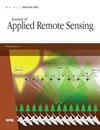Multi-depth temperature prediction using machine learning for pavement sections
IF 1.4
4区 地球科学
Q4 ENVIRONMENTAL SCIENCES
引用次数: 0
Abstract
The temperature of hot mix asphalt (HMA), base, and subgrade layers plays a significant role in pavement performance, because temperature influences the strength of the materials. Therefore, a model to predict temperature throughout the entire pavement structure is desirable. However, most existing models only focus on predicting the temperature of the road surface or the HMA layer, and these models usually need some information related to boundary conditions or material properties that is difficult to obtain. This research aims to demonstrate that machine learning (ML) model can be a powerful generalized approach to predict the temperature within a pavement structure at multiple depths. Data collected from sensors (thermistors and time domain reflectometers) installed in the Integrated Road Research Facility test road in Edmonton, Alberta, Canada, were used to train ML models. Sensitivity analysis was performed to analyze the influence of several input parameters on asphalt and soil temperature. ML models with three input parameters—average daily air temperature, day of the year, and depth—resulted in better performance compared to ML models based on other combinations of parameters. Three ML models were established to predict the average daily temperature, minimum daily temperature, and maximum daily temperature of the pavement structure. To validate model performance, the three ML models were compared with four existing models, and of these the ML models showed the highest accuracy with the coefficient of determination values above than 0.97 and root mean square error values below than 2.21. These results demonstrate that ML models can be used to give accurate predictions of road temperature at multiple depths with only one environmental predictive parameter, average daily air temperature.利用机器学习对路面断面进行多深度温度预测
热拌沥青(HMA)、基层和底基层的温度对路面性能起着重要作用,因为温度会影响材料的强度。因此,我们需要一个能预测整个路面结构温度的模型。然而,现有的大多数模型只侧重于预测路面或 HMA 层的温度,而且这些模型通常需要一些与边界条件或材料特性相关的信息,而这些信息很难获取。本研究旨在证明,机器学习(ML)模型是一种强大的通用方法,可用于预测多深度路面结构内的温度。从安装在加拿大艾伯塔省埃德蒙顿市综合道路研究设施测试道路上的传感器(热敏电阻和时域反射仪)收集的数据被用于训练 ML 模型。进行了敏感性分析,以分析几个输入参数对沥青和土壤温度的影响。与基于其他参数组合的 ML 模型相比,使用三个输入参数(日平均气温、年份和深度)的 ML 模型性能更好。建立了三个 ML 模型来预测路面结构的日平均温度、日最低温度和日最高温度。为了验证模型的性能,将三个 ML 模型与现有的四个模型进行了比较,其中 ML 模型显示出最高的准确性,其决定系数值大于 0.97,均方根误差值小于 2.21。这些结果表明,只需一个环境预测参数(日平均气温),ML 模型就能准确预测多个深度的路面温度。
本文章由计算机程序翻译,如有差异,请以英文原文为准。
求助全文
约1分钟内获得全文
求助全文
来源期刊

Journal of Applied Remote Sensing
环境科学-成像科学与照相技术
CiteScore
3.40
自引率
11.80%
发文量
194
审稿时长
3 months
期刊介绍:
The Journal of Applied Remote Sensing is a peer-reviewed journal that optimizes the communication of concepts, information, and progress among the remote sensing community.
 求助内容:
求助内容: 应助结果提醒方式:
应助结果提醒方式:


